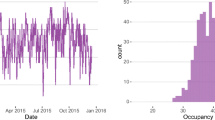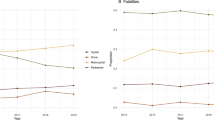Abstract
Crowd simulation is rapidly becoming a standard tool for evacuation planning and evaluation. However, the many crowd models in the literature are structurally different, and few have been rigorously calibrated against real-world egress data, especially in emergency situations. In this paper we describe a procedure to quantitatively compare different crowd models or between models and real-world data. We simulated three models: (1) the lattice gas model, (2) the social force model, and (3) the RVO2 model, and obtained the distributions of six observables: (1) evacuation time, (2) zoned evacuation time, (3) passage density, (4) total distance traveled, (5) inconvenience, and (6) flow rate. We then used the DISTATIS procedure to compute the compromise matrix of statistical distances between the three models. Projecting the three models onto the first two principal components of the compromise matrix, we find the lattice gas and RVO2 models are similar in terms of the evacuation time, passage density, and flow rates, whereas the social force and RVO2 models are similar in terms of the total distance traveled. Most importantly, we find that the zoned evacuation times of the three models to be very different from each other. Thus we propose to use this variable, if it can be measured, as the key test between different models, and also between models and the real world. Finally, we compared the model flow rates against the flow rate of an emergency evacuation during the May 2008 Sichuan earthquake, and found the social force model agrees best with this real data.
Similar content being viewed by others
References
G.K. Still, Ph.D. thesis, University of Warwick, 2000
S. Zhou, D. Chen, W. Cai, L. Luo, M.Y.H. Low, F. Tian, V.S.H. Tay, D.W.S. Ong, B.D. Hamilton, ACM Trans. Mod. Comput. Simul. 20, 20 (2010)
S. Gwynne, E. Galea, M. Owen, P. Lawrence, L. Filippidis, Building and Environment 34, 741 (1999)
S. Regelous, K. Mannion, Massive Software – Simulating Life (2011)
C.W. Reynolds, Comput. Graph. 21, 25 (1987)
J. Snape, Reciprocal collision avoidance and navigation for video games, in Game Developers Conf., San Francisco, 2012
R.E. Ensemble Studios, Big Huge Games, Age of empires (2013), http://ageofempiresonline.com/en/
D. Helbing, P. Molnár, Phys. Rev. E 51, 4282 (1995)
V. Viswanathan, M. Lees, in Transactions on Computational Science, edited by M.L. Gavrilova, K.C. Tan, C.V. Phan (Springer, 2012), pp. 1–20
S.J. Guy, J. Chhugani, S. Curtis, P. Dubey, M. Lin, D. Manocha, in Proceedings of the 2010 ACM SIGGRAPH/Eurographics Symposium on Computer Animation, Aire-la-Ville, 2010, SCA ’10, pp. 119–128, http://dl.acm.org/citation.cfm?id=1921427.1921446
H. Klüpfel, M. Schreckenberg, T. Meyer-König, in Traffic and Granular Flow ’03, edited by S. Hoogendoorn, S. Luding, P. Bovy, M. Schreckenberg, D. Wolf (Springer, Berlin, Heidelberg, 2005), pp. 357–372
J.D.A. Richard D. Peacock, E.D. Kuligowski, Pedestrian And Evacuation Dynamics (Springer, 2011)
A. Mordvintsev, V. Krzhizhanovskaya, M. Lees, P.M.A. Sloot, Pedestrian and Evacuation Dynamics, 2012 (in press). Available at http://www.science.uva.nl/research/pscs/papers/archive/Mordvintsev2012a .pdf
L. Henderson, Transportation Res. 8, 509 (1974)
J.M. Watts Jr., Fire Safety Journal 12, 237 (1987)
S. Paris, J. Pettré, S. Donikian, Computer Graphics Forum 26, 665 (2007)
A Pattern-based Modeling Framework for Simulating Human-like Pedestrian Steering Behaviors, edited by S.Z. Nan Hu, Michael Lees (ACM, 2013) (to appear)
A. Johansson, D. Helbing, H.Z. Al-abideen, S. Al-bosta, Adv. Compl. Syst. 11, 497 (2008)
S. Okazaki, S. Matsushita, Engineering for Crowd Safety (Elsevier, Amsterdam, 1993)
J. Ondřej, J. Pettré, A.H. Olivier, S. Donikien, ACM Transactions on Graphics (TOG) 29, 123 (2010)
J. van den Berg, S.J. Guy, M.C. Lin, D. Manocha, in Robotics Research: The 14th International Symposium ISRR (Springer, 2011), Vol. 70
S.J. Guy, J. van den Berg, M.C. Lin, in Symposium on Computer Graphics, University of North Carolina, Proceedings of the 2010 annual symposium on Computational geometry, Utah, 2010, pp. 115–116
J. van den Berg, M.C. Lin, D. Manocha, Reciprocal Velocity Obstacles for real-time multi-agent navigation, in IEEE International Conference on Robotics and Automation, 2008. ICRA 2008, pp. 1928–1935
R. Hughes, Ann. Rev. Fluid Mech. 35, 169 (2003)
D. Helbing, P. Mukerji, Europhys. J. Data Sci. 1, 1 (2012)
Simulating Complex Systems by Cellular Automata, edited by A.G. Hoekstra, J. Kroc, P.M.A. Sloot, Understanding Complex Systems (Springer, 2010)
S. Marconi, Ph.D. thesis, Université de Genève, 2002
S. Marconi, B. Chopard, in Cellular Automata, edited by S. Bandini, B. Chopard, M. Tomassini (Springer, Berlin, Heidelberg, 2002), Vol. 2493 of Lecture Notes in Computer Science, pp. 231–238
R. Nagai, T. Nagatani, M. Isobe, T. Adachi, Physica A 343, 712 (2004)
K. Nishinari, A. Kirchner, A. Namazi, A. Schadschneider, IEICE Trans. Inform. Sys. 87, 726 (2004)
C.M. Henein, T. White, Crowds and Cellular Automata, Vol. 4173 of Lecture Notes in Computer Science (Springer, Berlin, Heidelberg, 2006)
Y. Tajima, T. Nagatani, Physica A 292, 545 (2001)
M. Isobe, T. Adachi, T. Nagatani, Physica A 336, 638 (2004)
A. Kamphuis, M.H. Overmars, in Proceedings of the 2004 ACM SIGGRAPH Symposium on Computer Animation, Utrecht University, 2004
H. Xi, S. Lee, Y.J. Son, An Integrated Pedestrian Behavior Model Based on Extended Decision Field Theory and Social Force Model, in 2010 Winter Simulation Conference, 2010, pp. 824–836
G. Peng, X. Ruihua, Pedestrian and Evacuation Dynamics 2008 (Springer, 2010), pp. 585–595
D. Helbing, I. Farkas, T. Vicsek, ArXiv:0009448V1 [cond-mat.stat-mech] (2002)
P. Fiorini, Z. Shiller, in Proceedings. IEEE International Conference on Robotics and Automation, 1993, pp. 560–565
J. van den Berg, S. Patil, J. Sewall, D. Manocha, M.C. Lin, in 2008 symposium on Interactive 3D graphics and games, University of North Carolina, 2008
S.J. Guy, J. Chhugani, C. Kim, N. Satish, M.C. Lin, D. Manocha, P. Dubey, in SCA ’09: Proceedings of the 2009 ACM SIGGRAPH/Eurographics Symposium on Computer Animation, ACM Request Permissions, 2009
S.J. Guy, M.C. Lin, D. Manocha, in 9th Int. Conf. on Autonomous Agents and Multiagent Systems (AAMAS 2010), Toronto, 2010, pp. 575–582
S. Luke, C. Cioffi-Revilla, L. Panait, K. Sullivan, G. Balan, Simul. Trans. Soc. Mod. Simul. Int. 82, 517 (2005)
X. Pan, Ph.D. thesis, Stanford University, 2006
J. Fruin, Public Transportation in the United States (Englewoods Cliffs, Prentice Hall, 1992)
D. Bauer, in Pedestrian and Evacuation Dynamics, edited by R.D. Peacock, E.D. Kuligowski, J.D. Averill (Springer, US, 2011), pp. 547–556
A. Seyfried, A. Schadschneider, in Cellular Automata, edited by H. Umeo, S. Morishita, K. Nishinari, T. Komatsuzaki, S. Bandini (Springer, Berlin, Heidelberg, 2008), Vol. 5191 of Lecture Notes in Computer Science, pp. 563–566
J. Lin, IEEE Trans. Inform. Theor. 37, 145 (1991)
H. Abdi, D. Valentin, U.D. Bourgogne, B. Edelman, in Proceedings of the IEEE Computer Society: International Conference on Computer Vision and Pattern Recognition, 2005, pp. 42–47
X. Yang, Z. Wu, Natural Hazards 65, 1765 (2013)
X. Yang, Z. Wu, Y. Li, Physica A 390, 2375 (2011)
Author information
Authors and Affiliations
Corresponding author
Rights and permissions
About this article
Cite this article
Viswanathan, V., Lee, C.E., Lees, M.H. et al. Quantitative comparison between crowd models for evacuation planning and evaluation. Eur. Phys. J. B 87, 27 (2014). https://doi.org/10.1140/epjb/e2014-40699-x
Received:
Revised:
Published:
DOI: https://doi.org/10.1140/epjb/e2014-40699-x




